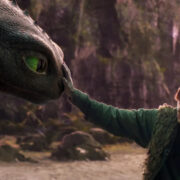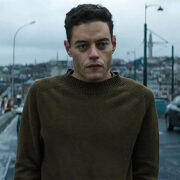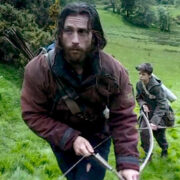IRON SKY: THE COMING RACE: Putting The “Hollow” In “Hollow Earth”
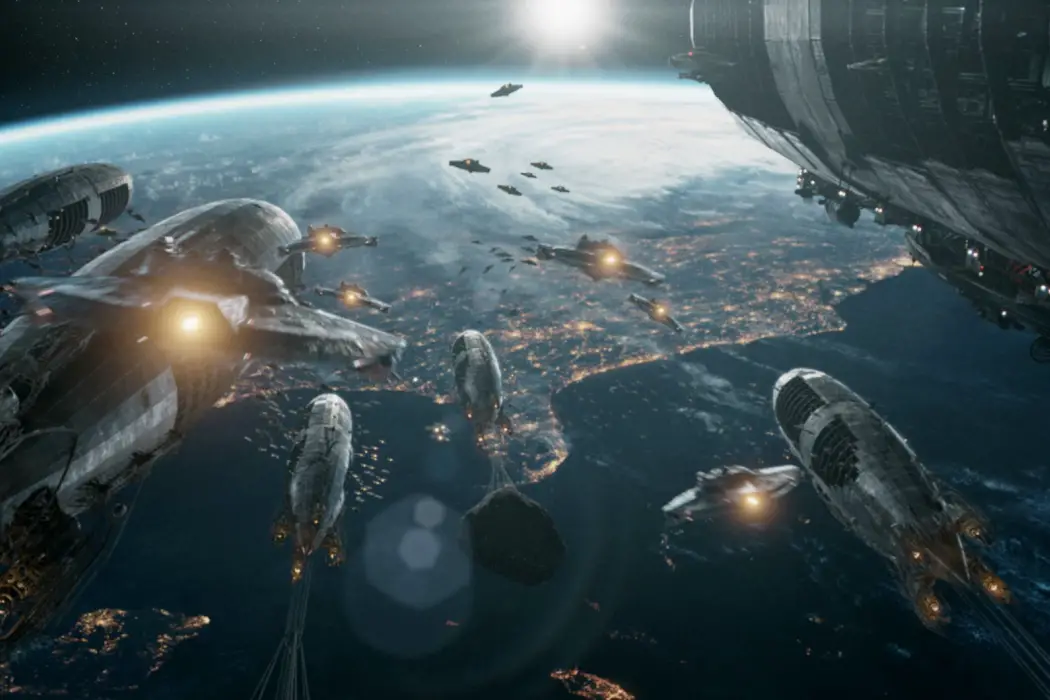
I'm a film journalist and independent filmmaker who fell in…
Even when it existed merely as a proof-of-concept trailer for potential hungry-eyed investors, Timo Vuroensola’s Iron Sky (2012), which put the spotlight on “Nazis in space”, was destined for cult status in the world of cinema. A crowd-funded endeavour, the Finnish film infused its canvas of pulpy ideas and visuals with a respectable amount of cine-literacy, topping it off with irreverent humour and satire. While largely uneven in its comedy and execution, its ambitions and influences were evident, and Vuroensola would go on to develop a (similarly crowd-funded) sequel, Iron Sky: The Coming Race.
As a result of the scheming Moon Nazis and the damage done to international relations, Earth of 2018 has suffered a nuclear apocalypse. A small faction of survivors flee to the dark side of the moon where they join the former Moon Nazis at their damaged base, “Neomenia”. By the year 2047, the base suffers from dwindling food and supplies, overpopulation, prejudice and overall, a lack of hope. Renate Richter (Julia Dietze), terminally ill and in charge of overseeing the Neomenia’s interests, finds comfort and solace in the base’s religion, Jobsism, a cult revolving around the teachings of Steve Jobs, and founded by a corporate-minded Donald (Tom Green).
After Richter orders the detainment of the passengers of a Russian refugee ship, her daughter and the base’s tech-savvy mechanic, Obianaju “Obi” Washington (Lara Rossi), discovers the presence of the base’s former Moonfuhrer, Wolfgang Kortzfleisch (Udo Kier). He reveals himself to be a Vril, a race of reptilians who came to earth during the prehistoric age, and presents her with Vrillia, a “fountain of youth” energy substance that contains healing powers capable of curing Renate’s condition. After restoring Renate to a younger, healthier self, Wolfgang coaxes Obi into stealing Vrillia from the city of Agartha at the centre of the earth (which is hollow), in order to ensure the survival of her colony. Deciding to brave the dinosaurs and Vril that reside in Agartha, Obi heads over there, taking with her a few oddball characters .
Flat Execution & Wooden Acting
Iron Sky: The Coming Race inherits its predecessor’s outrageous imagination and continues to laugh in the face of political correctness, while also expanding on a world that gladly plays host to a number of legendary conspiracy theories. The fairly intriguing setup teases the promise of potentially delicious commentary on Donald Trump’s era of border politics, detention facilities and immigration, wrapped in the framework of science fantasy that boasts hidden worlds, interplanetary travel, and mythical ideas.
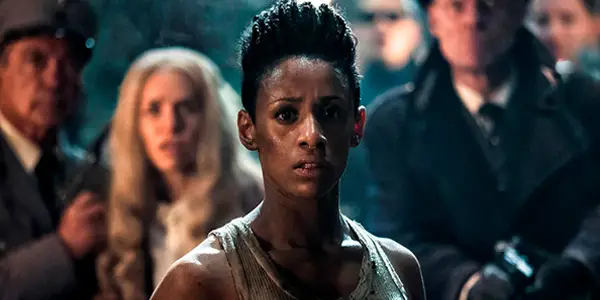
Unfortunately, the filmmakers do not care enough for the story they are telling to deliver on these promises, or on the bare minimum for that matter. The issue isn’t with the content or structure of the story, but rather because the the writing is unbelievably thin. No idea pays off as well as it should and the lack of danger and stakes makes it impossible to get invested in the mechanics of the plot. The filmmakers don’t even bother leaving an emotional impact especially in the film’s (supposedly) heartfelt moments where the death of a character leaves us emotionally detached because they seem to be glossed over.
The Coming Race has a few too many characters who are, at best, only sketchily developed (including the returning Renate Richter), carrying on the first film’s tendency to populate the story with fairly obnoxious caricatures. Obi is a wasted opportunity of a heroine who doesn’t do or say anything interesting, and instead reminds us of better crafted characters in the Star Wars series (an obvious inspiration for these films). Even as archetypes, the characters come off as lacklustre and uninspired, and the villains of the piece are a major joke, and only exist to service the film’s paraphernalia of satirical set-pieces. More insulting, however, is how the film fails to give us any logical reason as to why most of the characters should really join Renate on her quest.
It doesn’t help that the film plays out like a piece of pantomime invoking low-rent genre films from the eighties and nineties (which the series occasionally tips its hat to), with the overall acting coming off as amateurish and wooden. The actors are also forced to utter expository and obvious dialogue, without any genuine belief or conviction in their words. While Lara Rossi gives it her best, she seems too under-directed to win us over, and neither can Vladmir Burlakov, who plays the Russian pilot Sasha, nor Kit Dale as Malcolm, the base’s brave security officer. Tom Green appears to be the discount version of Wallace (as portrayed by Jared Leto) from Blade Runner 2049; not entirely nauseating but not leaving a lasting impression either.
Udo Kier, in his dual roles as Kortzfleisch and his brother, Vrill Hitler, is the only magnetic personality within the melange of hokey performances, using his arresting presence, commanding eyes and unique diction to the best of his efforts. Whether he takes the film seriously or not isn’t abundantly clear, and whether he believes that he is in a different film is a whole other topic entirely.
Missing the punchline
The main issue with The Coming Race is that it is almost entirely devoid of laughs or smart humour, especially given the franchises’s obvious, extensive knowledge of cinema and world issues. Save for a couple of chuckle-worthy moments, the jokes are quite corny, ill-timed and too on-the-nose for their own good.
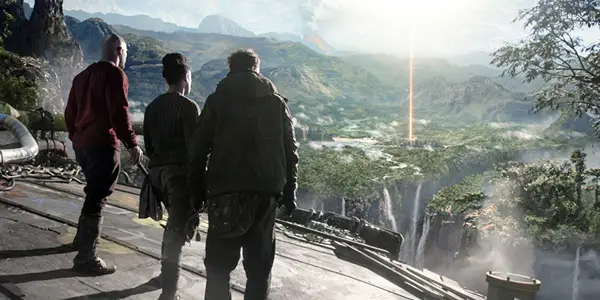
The worst crime of all is that the satire seems like an unmotivated component of the sound-and-light show that the film essentially is. When a member of the cult of Jobsism becomes excommunicated in a brutal fashion, the scene is played out much too seriously that it becomes obvious that the commentary exists in its own bubble and becomes a disjointed element of the overall narrative. As much as Jobsism draws rather explicit parallels between the the dehumanisation of the corporate world and sheepish victims of religious organisations, it doesn’t produce any meaningful insight as much as the introduction to the ED-209 in Robocop (1987) does, where we can fully understand the complications, dangers and nuances of that world very quickly.
In a visual reference to Leonardo Da Vinci’s “The Last Supper Painting”, Vril versions of malicious figures from history (including Mark Zuckerberg) find themselves dining at a large table without any purpose other than to incite laughter from the audience. They don’t, and they also prove the film’s over-reliance on setting up jokes up without understanding the need for pay-off, purpose or a simple visceral punch. It is almost reminiscent of the first film’s joke about the devious nature of Nazi rhetoric where they would screen a highly edited version Charlie Chaplin’s The Great Dictator (1940), which limits the footage to only portray the Adolf Hitler cypher in a positive and powerful light. It’s quite the mark of genius, but as the narrative brings us back to the joke, the payoff is barely given any weight.
Aesthetics & Influences
Even with its numerous shortcomings, The Coming Race shares a wondrous sense of visual flair with its predecessor, be it through its 3D environments & CGI creations or in its practical effects. Just as Iron Sky brought to life a swastika-shaped lunar base filled with beautifully intricate details of 1940s aesthetics and technology (with space-objects and vehicles that feel like miniatures or backgrounds that come across as matte paintings), The Coming Race explores the idea of a dystopia within the base, giving us the impression that Neomenia houses black markets and hidden societies. Even the dinosaur-filled centre of the earth feels realised, despite the fact that it can’t compete with the visual effects of blockbusters like those of the Marvel Cinematic Universe.
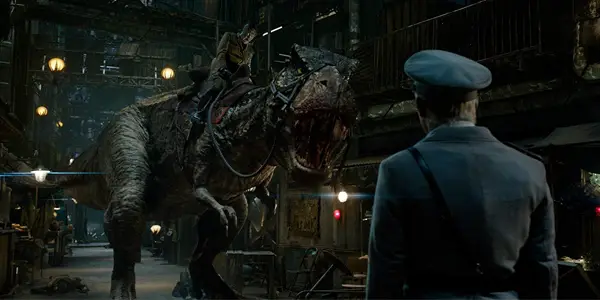
It’s the infectious love of comic books, pulp novels and cinema (both high-brow and low-brow) that made the first Iron Sky so memorable, especially with its uncanny ability to mash up genres and portray preposterous ideas like Aryanisation (it’s weird, and wrong), dog fights in space (inspired by Star Wars) or even using dinosaurs as beasts of burden (think if The Flinstones met The Valley of Gwangi).
In fact, “preposterous” may be the wrong word, depending on who you are. If anyone reads a comic book by Alan Moore or Grant Morrison, then they’d come to the realisation that there is no such thing as a bad idea, no matter infantile or wacky it may be. All that matters is that you mine it for as much gold as it can reveal.
Iron Sky: The Coming Race Conclusion
It’s hard to recommend Iron Sky: The Coming Race to anyone who hasn’t seen the first instalment, which, admittedly, is not a film for everyone, despite the fact that it has a lot of interesting ideas and images. The Coming Race doesn’t have the love and affection of its predecessor, nor does it have a sense of discipline or focus, and unfortunately falls flat.
However, it would be a lie to say that it didn’t have the potential to rectify its problems, and that the series wouldn’t be able to venture into interesting places, as the very last shot of the film may indicate.
What did you think of Iron Sky: The Coming Race? Do you like it as much as the first film or does it miss the mark? Let us know in the comments below!
Iron Sky: The Coming Race was released in theatres in the U.S. on April 24th 2019, for a limited time, and became available on DVD & Blu-ray on May 6th 2019.
Does content like this matter to you?
Become a Member and support film journalism. Unlock access to all of Film Inquiry`s great articles. Join a community of like-minded readers who are passionate about cinema - get access to our private members Network, give back to independent filmmakers, and more.
I'm a film journalist and independent filmmaker who fell in love with cinema at a young age. I also love writing about comics, literature, podcasts, television and video games. I'm just as content watching a movie about a giant killer pig terrorising the Australian outback as I am with one that features a catholic priest in crisis.






